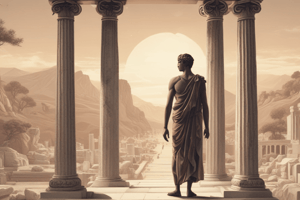Podcast
Questions and Answers
Greek art primarily developed from around 900 BC to 30 AD.
Greek art primarily developed from around 900 BC to 30 AD.
False (B)
Greek art heavily influenced Roman art and the ideals of the Renaissance.
Greek art heavily influenced Roman art and the ideals of the Renaissance.
True (A)
Greek art rarely depicted gods and heroes.
Greek art rarely depicted gods and heroes.
False (B)
Balance and realism are key characteristics of Greek art.
Balance and realism are key characteristics of Greek art.
Greek architecture is considered one of the lesser-known aspects of Greek art.
Greek architecture is considered one of the lesser-known aspects of Greek art.
Flashcards are hidden until you start studying
Study Notes
Greek Art
- Refers to visual arts created by ancient Greek civilization, primarily from 900 BC to 30 BC.
- Known for its focus on ideal beauty, balance, and realism.
- Influenced Western art for centuries.
Legacy of Greek Art
- Lasting influence on Roman art, Renaissance ideals, and Modern Western aesthetics.
- Celebrated for its exploration of humanism, beauty, and technical mastery.
Greek Art and Mythology
- Deeply intertwined with Greek mythology and religious beliefs.
- Gods and heroes were commonly depicted in sculptures, pottery, and temples.
- Revealed Greek reverence for the divine and an admiration for human strength, intellect, and beauty.
Examples of Greek Art
- Painting
- Sculpture
- Architecture
Studying That Suits You
Use AI to generate personalized quizzes and flashcards to suit your learning preferences.




